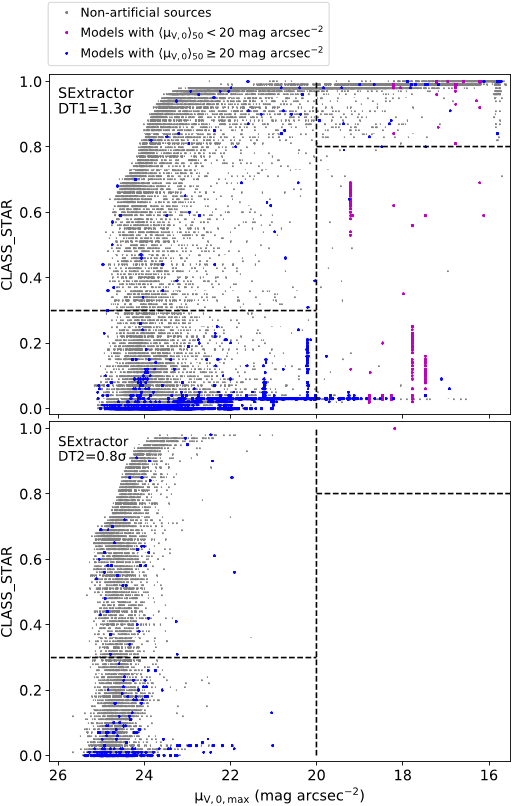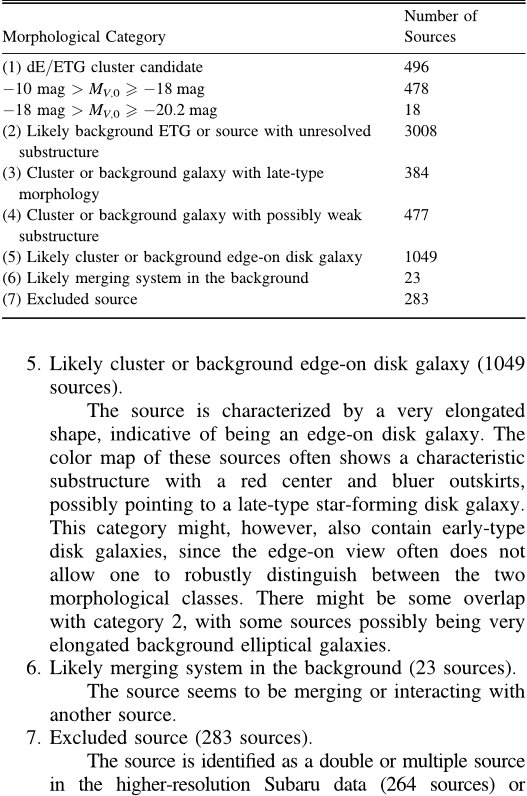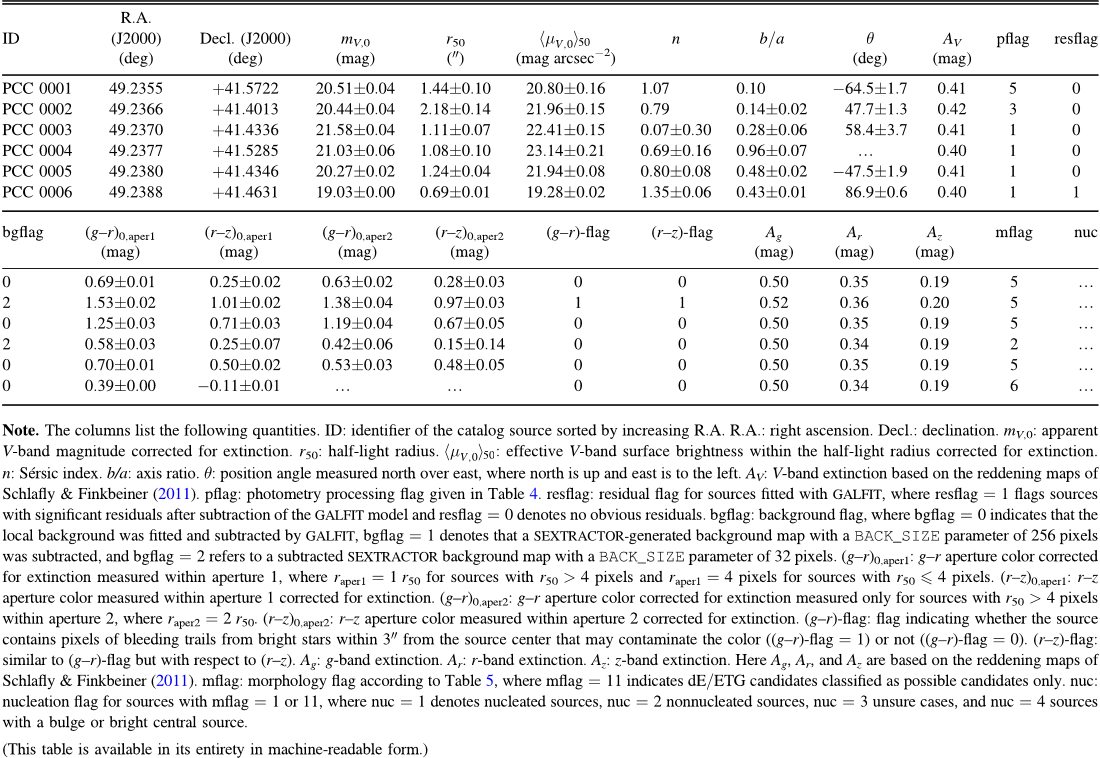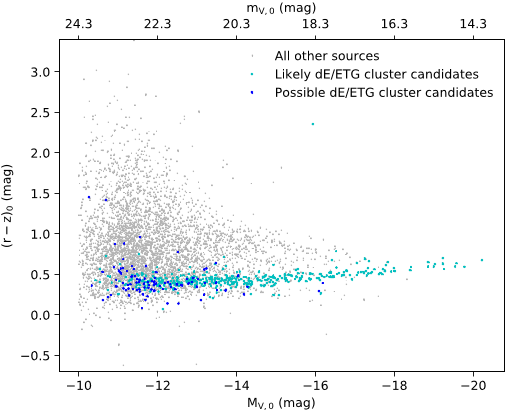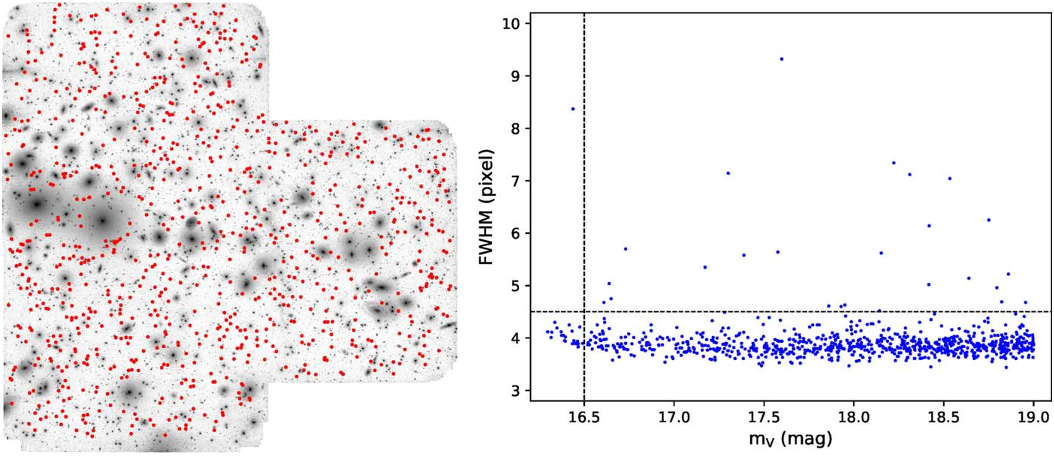
A Catalog of Galaxies in the Direction of the Perseus Cluster
Carolin Wittmann
1
, Ralf Kotulla
2
, Thorsten Lisker
1
, Eva K. Grebel
1
, Christopher J. Conselice
3
, Joachim Janz
4,5
, and
Samantha J. Penny
6
1
Astronomisches Rechen-Institut, Zentrum für Astronomie der Universität Heidelberg, Mönchhofstraße 12-14, D-69120 Heidelberg, Germany
carolin@dwarfgalaxies.net
2
Department of Astronomy, University of Wisconsin at Madison, 475 North Charter Street, Madison, WI 53706-1582, USA
3
School of Physics and Astronomy, University of Nottingham, Nottingham NG7 2RD, UK
4
Astronomy Research Unit, University of Oulu, Pentti Kaiteran katu 1, FI-90014 Oulu, Finland
5
Finnish Centre of Astronomy with ESO (FINCA), University of Turku, Vaisalantie 20, FI-21500 Piikkio, Finland
6
Institute of Cosmology and Gravitation, University of Portsmouth, Burnaby Road, Portsmouth PO1 3FX, UK
Received 2019 May 30; revised 2019 September 15; accepted 2019 September 25; published 2019 November 11
Abstract
We present a catalog of 5437 morphologically classified sources in the direction of the Perseus galaxy cluster core,
among them 496 early-type low-mass galaxy candidates. The catalog is primarily based on V-band imaging data
acquired with the William Herschel Telescope, which we used to conduct automated source detection and derive
photometry. We additionally reduced archival Subaru multiband imaging data in order to measure aperture colors
and perform a morphological classification, benefiting from 0
5 seeing conditions in the r-band data. Based on
morphological and color properties, we extracted a sample of early-type low-mass galaxy candidates with absolute
V-band magnitudes in the range of −10 to −20 mag. In the color–magnitude diagram, the galaxies are located
where the red sequence for early-type cluster galaxies is expected, and they lie on the literature relation between
absolute magnitude and Sérsic index. We classified the early-type dwarf candidates into nucleated and
nonnucleated galaxies. For the faint candidates, we found a trend of increasing nucleation fraction toward brighter
luminosity or higher surface brightness, similar to what is observed in other nearby galaxy clusters. We
morphologically classified the remaining sources as likely background elliptical galaxies, late-type galaxies, edge-
on disk galaxies, and likely merging systems and discussed the expected contamination fraction through non-early-
type cluster galaxies in the magnitude-size surface brightness parameter space. Our catalog reaches its 50%
completeness limit at an absolute V-band luminosity of −12 mag and a V-band surface brightness of
26 mag arcsec
−2
. This makes it the largest and deepest catalog with coherent coverage compared to previous
imaging studies of the Perseus cluster.
Key words: catalogs – galaxies: clusters: individual (Perseus) – galaxies: dwarf – galaxies: photometry
Supporting material: machine-readable tables
1. Introduction
Galaxy clusters are the densest regions with the highest
galaxy number densities in the universe. They contain a wide
variety of stellar systems, ranging from the cluster central
galaxy, which is typically the most luminous cluster member;
to over all kinds of early- and late-type galaxies from the giant
to the dwarf scale; to very small stellar systems like compact
elliptical galaxies, ultracompact dwarf galaxies, and globular
clusters.
Galaxy clusters continuously grow by accreting individual
galaxies, as well as entire galaxy groups. At the same time, they
transform or even destroy the newly arrived members. Ram
pressure, exerted by the intracluster medium, leads to stripping
and depletion of an infalling galaxy’s gas reservoir (Gunn &
Gott 1972), preventing the fueling of further star formation and
turning the galaxy red in color due to its aging stellar
population. Tidal stripping or heating induced by the overall
cluster potential or close passages of massive cluster galaxies
may result in a perturbation or even the destruction of the
stellar galaxy component (e.g., Moore et al. 1998; Gnedin 2003;
Bialas et al. 2015; Smith et al. 2015). These cluster
environmental processes result in different properties for
cluster and field galaxies and are thought to give rise to the
observed relations between morphology and color with
environmental density (Dressler 1980; Binggeli et al. 1987;
Bamford et al. 2009), where red non-star-forming early-type
galaxies (ETGs) dominate in high-density regions and blue
star-forming late-type galaxies (LTGs) are preferentially
located in lower-density environments.
Although dwarf galaxies only make up a minor fraction of
the total luminosity and mass content of all cluster galaxies,
they are the dominant cluster population by numbers. This
makes them ideal tracers of a cluster’s assembly history.
Signatures of their infall and accretion history will still be
imprinted in their spatial and velocity distribution after several
gigayears, since dwarf galaxies are insensitive to dynamical
friction (Vijayaraghavan et al. 2015). Dwarf galaxies are also
valuable indicators to study cluster environmental processes.
Due to their low masses and shallow gravitational potential
wells, dwarf galaxies are thought to be particularly sensitive to
external influences (e.g., Penny et al. 2014a).
Pioneering work in cataloging and studying dwarf popula-
tions in galaxy clusters was carried out by Binggeli et al. (1985)
in the Virgo cluster and Ferguson (1989)
in the Fornax cluster.
Until today, these two environments constituted the best-
studied nearby clusters in terms of their galaxy populations,
from which a lot of insight was gained with regard to
understanding galaxy evolution. Also, the more distant Coma
galaxy cluster generated a lot of interest, leading to a well-
studied galaxy population in an even more massive cluster
The Astrophysical Journal Supplement Series, 245:10 (25pp), 2019 November https://doi.org/10.3847/1538-4365/ab4998
© 2019. The American Astronomical Society. All rights reserved.
1

environment compared to Virgo and Fornax (e.g., Godwin
et al. 1983; Carter et al. 2008; Michard & Andreon 2008).
Recent deep wide-field imaging surveys of Virgo (Next
Generation Virgo Cluster Survey; Ferrarese et al. 2012),
Fornax (Fornax Deep Survey (FDS); Venhola et al. 2018; Next
Generation Fornax Cluster Survey; Muñoz et al. 2015), and
Coma (Koda et al. 2015) pushed the detection limits to very
faint luminosities and surface brightnesses, allowing one to
detect dwarf galaxy members even in the regime of Local
Group dwarf spheroidals.
The Perseus galaxy cluster is another nearby rich galaxy
cluster at a distance of ∼70 Mpc. With a virial mass on the
orderof8.5×10
14
M
e
(Mathews et al. 2006) ,itisclearly
more massive than Fornax and Virgo and a factor of ∼1.5 less
massive than the more distant Coma cluster. There are
signs that Perseus is a dynamically young environment, like
Virgo, with indications of ongoing assembly (Andreon 1994;
Brunzendorf & Meusinger 1999). The cluster has a variety of
interesting properties, for example, the peculiar central galaxy
NGC 1275, very bright X-ray emission, and a high cluster
velocity dispersion (see Conselice et al. 2002). This makes
Perseus stand out as another unique rich cluster environment
inthenearbyuniversewithinteresting prospects to study
environm en tal influences on its galax y popul at ion. Nev er-
theless, Perseus has not yet been studied in similar detail as
Virgo, Fornax, and Coma.
The Perseus cluster is partly covered by the Sloan Digital
Sky Survey (SDSS; Ahn et al. 2012), but the data do not probe
far into the dwarf galaxy luminosity and size regime at the
distance of Perseus, due to the rather shallow depth and
comparably low spatial resolution of the data. Brunzendorf &
Meusinger (1999) presented a catalog of 660 brighter galaxies,
with B
25
<19.5 mag, which they detected on a 10 deg
2
area of
the Perseus cluster based on digitized Schmidt plates. Deeper
and higher-resolution imaging studies of a 0.3×0.3 Mpc
2
region of the cluster core were conducted by Conselice et al.
(2002, 2003), based on multiband imaging data acquired with
the WIYN 3.5 m telescope, revealing a sample of 53 dwarf
galaxy candidates. About 30 possible and confirmed dwarf
cluster members, partly overlapping with the above sample,
were studied in detail based on observations with the Hubble
Space Telescope (HST) by De Rijcke et al. (2009) and Penny
et al. (2009). A deep wide-field survey conducted with the
William Herschel Telescope (WHT) was presented in Witt-
mann et al. (2017). Their observations cover 0.7×0.7 Mpc
2
of
the central cluster region and reach a 5σ V-band depth of
∼27 mag arcsec
−2
, which allowed them to identify a popula-
tion of 89 faint low surface brightness galaxy candidates with
a mean effective V-band surface brightness fainter than
25 mag arcsec
−2
.
In this study, we present a new catalog of sources in the
direction of the Perseus cluster core based on the WHT V-band
data described in Wittmann et al. (2017). It is a collection of
both likely cluster members and sources in the background,
with our primary focus being extracting a sample of early-type
low-mass galaxy candidates. We used the WHT V-band mosaic
to perform an automated source detection with
SEXTRACTOR
(Bertin & Arnouts 1996), which we tuned to be most efficient
at detecting faint extended sources. The most reliable approach
in discriminating cluster from background galaxies is based on
radial velocity measurements. However, in the faint luminosity
regime of dwarf galaxies, so far only a handful of sources have
been spectroscopically confirmed in Perseus (Penny &
Conselice 2008). We therefore performed a morphological
analysis of all sources detected in our WHT V-band mosaic.
Selecting early-type dwarf galaxies based on their morpholo-
gical appearance has been demonstrated to be quite successful,
e.g., by Binggeli et al. (1985) and Conselice et al. (2002).
However, the success of a correct morphological classification
greatly depends on the spatial resolution of the imaging data in
order to reveal the substructure of possible background
galaxies. Therefore, we examined archival Subaru HyperSu-
primeCam (HSC) data with very good seeing conditions that
overlap with our WHT V-band footprint, allowing us to
perform a very high quality morphological classification even
for small and faint sources.
This paper is structured as follows. In Section 2 we
characterize the data sets used for this study. In Section 3 we
outline the source detection and give a quantitative complete-
ness estimate for the catalog. The photometric measurements
are described in Section 4. In Section 5 we explain the
morphological classification. Our final catalog is presented in
Section 6. We provide a discussion on the parameter
distributions of the morphologically classified sources in
Section 7 and perform a literature comparison in Section 8.
We summarize the results of this study in Section 9.
Throughout the paper, we adopt a distance of 72.3 Mpc to
the Perseus cluster and a scale of 20.32 kpc arcmin
−1
(Struble
& Rood 1999, using the “cosmology-corrected” quantities
from the NASA/IPAC Extragalactic Database (NED), with
H
0
=73.0 km s
−1
Mpc
−1
, Ω
matter
=0.27, Ω
vacuum
=0.73).
2. Data
We performed the source detection and photometry in our
V-band mosaic of the Perseus cluster core, which we presented
and described in Wittmann et al. (2017; see their Figure 1 and
Figure 1 in this paper). The mosaic is based on imaging data
acquired with the prime focus imaging platform at the WHT
(program 2012B/045; PI: T. Lisker ). It covers a region of
0.27 deg
2
, which corresponds to 0.41 Mpc
2
at the distance of
Perseus and extends to a clustercentric distance of 0.57 °
(
= 0.70
Mpc). The mosaic is characterized by an image depth
of 27 mag arcsec
−2
in the V band at a signal-to-noise ratio
(S/N) of 1 pixel
–1
, with a pixel scale of 0.237 arcsec pixel
−1
.
The average seeing FWHM corresponds to 0
9.
The WHT data constitute our primary data set that we used
to establish the catalog. When starting to work on the catalog,
we had the fully reduced WHT V-band mosaic already in hand,
and we were convinced that the data would be well suited for
automated source detection and photometry based on our
experience in Wittmann et al. (2017), where we used the data
for visual detection and photometry of faint low surface
brightness galaxy candidates. We additionally reduced archival
Subaru HSC data in the g, r, and z bands, which served as an
auxiliary data set to improve the quality of the catalog. This
allowed us to benefit from the 0
5 seeing conditions in the
Subaru r-band data for the morphological analysis, as well as to
obtain color information by deriving g−r and r−z aperture
colors.
A full description of the reduction details for the Subaru data
set is presented in a forthcoming paper by Kotulla et al., so we
only present a short overview to provide critical information.
The HSC data set was compiled from a number of mostly
overlapping observations taken under two different proposals
2
The Astrophysical Journal Supplement Series, 245:10 (25pp), 2019 November Wittmann et al.

Figure 1. Top left: reduced WHT V-band mosaic of the Perseus cluster core. The x- and y-axes correspond to R.A. and decl., respectively. The black circle marks
NGC 1275. Top right: partly object-subtracted mosaic with overlaid mask indicating the excluded inner regions of extended high surface brightness sources. Bottom:
mosaic with subtracted
SEXTRACTOR background map (BACK_SIZE=64 pixels) and the high surface brightness object mask used for source detection. The gray-
scale bar indicates the surface brightness in mag arcsec
−2
. North is up, and east is to the left.
3
The Astrophysical Journal Supplement Series, 245:10 (25pp), 2019 November Wittmann et al.

in 2014 September and November, obtained from the Subaru-
Mitaka-Okayama-Kiso Archive (SMOKA; Baba et al. 2002).
Data reduction, including bias, dark, and flat-field correction,
followed by astrometric and photometric calibration, was
performed using the HSC pipeline (Version 5.4). All detrended
and calibrated images were then aligned and coadded into a
deep stack. To measure aperture colors, we coaligned all
bandpasses to the same pixel grid of the WHT data, allowing us
to reuse masks and photometry apertures consistently across all
bands and thus limiting systematic uncertainties and biases.
This was done using
SWARP (Bertin et al. 2002) to match pixel
scale, pointing, and field of view. Some statistics describing
these observations are summarized in Table 1. For the
morphological analysis, we used the r-band data with the
native HSC pixel scale of 0.168 arcsec pixel
−1
.
We publicly release the mosaics used in this study through
the German Astrophysical Virtual Observatory (GAVO); see
Section 6.
3. The Source Catalog
3.1. Source Detection
We established a catalog of sources in the direction of
Perseus based on detection with
SEXTRACTOR
7
on our WHT
V-band mosaic. Prior to detection, we fitted and subtracted the
light profiles of most of the bright galaxies and stellar halos
using
IRAF
8
ellipse. We additionally excluded the inner regions
of all subtracted sources, since they often show pronounced
residuals, as well as the bright centers of remaining sources that
were not subtracted. We therefore masked all regions that were
detected with
SEXTRACTOR in the original Perseus mosaic
(where no sources were subtracted) when requiring a detection
threshold above 5σ and more than 10,000 connected pixels. We
note that this results in a bright V-band magnitude limit of
−20 mag for our catalog and a reduced detection efficiency for
the larger sources with absolute V-band magnitudes brighter
than −19 mag (see Figure 4 and Section 3.3 ). The masked
regions in the partly object-subtracted WHT mosaic are
indicated in Figure 1 (top right and bottom panels).
We used a set of model galaxies inserted into our data to tailor
the
SEXTRACTOR parameter configuration especially to the
detection of faint galaxies. We generated a set of 69 model
galaxies spanning the parameter range of faint low-mass galaxies
from compact elliptical to faint low surface brightness galaxies
with absolute V-band magnitudes M
V,0
=−10 to −19 mag
(m
V,0
= 24.3–15.3 mag), half-light radii r
50
=0.2–7.8 kpc
(r
50
= 0 6–23 0), and effective surface brightnesses
m
á
ñ=
V,0
50
16 27–
mag arcsec
−2
at the distance of Perseus. In the following,
we denote extinction-corrected magnitudes by adding the
subscript “0”. For the model galaxies, we assumed an extinction
of A
V
=0.5 mag, which is the average value for the region
covered by the WHT mosaic footprint. For all nonartificial
sources, we obtained the extinction values at the position of the
respective source (see Sections 4.3 and 4.4).
We realized all model galaxies with a one-component Sérsic
n=1 profile and an ellipticity of ò=0.1 and convolved them
with a Gaussian kernel adopting our average WHT V-band
seeing point-spread function (PSF) FWHM of 0
9. For each
model, we generated one copy of our mosaic where we inserted
about 80 duplicates, requiring that they do not overlap with
each other or fall on one of the masked regions indicated in
Figure 1. The total number of models inserted into 69 different
mosaic copies amounts to 5478.
We ran
SEXTRACTOR several times with varying parameter
settings on the mosaics with the inserted model galaxies in order
to test which parameter configuration yields the highest detection
fractions. In particular, the parameters DT and DMIN, specifying
the minimum number of connected pixels (DMIN) above a
certain detection threshold (DT) that are required to result in a
detection, control which kind of sources will be detected.
Figure 2 shows that with a parameter configuration of
DT=1.3σ and DMIN=25 pixels, we are able to detect more
than 90% of all model galaxies with
m
á
ñ 2
4
V,0
50
mag arcsec
−2
.
A lower detection threshold of DT=0.8σ with the same DMIN
parameter improves the detection of fainter surface brightness
sources with
m
á
ñ>2
4
V,0
50
mag arcsec
−2
. However, although
both
SEXTRACTOR configurations yield similar detection fractions
for sources with
m
á
ñ 2
4
V,0
50
mag arcsec
−2
, the derived
photometry of the DT=0.8σ detections often turns out to be
less reliable. For example, sources with diffuse halos, which
would be detected as single objects with the DT=1.3σ
configuration, are frequently split up into multiple detections with
the DT=0.8σ parameter setting. Therefore, we adopted a two-
pass detection, where we first ran
SEXTRACTOR with a detection
threshold of DT1= 1.3σ and then with a detection threshold of
DT2=0. 8σ. We merged the source catalogs of both runs, where
we considered all sources from the DT1 run and additional
sources from the DT2 run that were not detected with the DT1
SEXTRACTOR parameter setting.
9
In both cases, we ran SEX-
TRACTOR
with internal filtering prior to source detection,
adopting a Gaussian filter with FWHM=4 pixels, which is on
the order of the average WHT V-band seeing PSF FWHM. To
take into account the noise properties of our mosaic during the
detection process, we furthermore provided a weight image
generated from our data, which is described in Wittmann et al.
(2017).
The detection of faint sources close to or superimposed with
brighter sources is very sensitive to the
SEXTRACTOR
deblending parameters, as well as the subtracted background
map, which is internally generated by
SEXTRACTOR. For
the deblending, we used a very low deblending contrast
(DEBLEND_MINCONT=0.00001) together with a high num-
ber of deblending thresholds (DEBLEND_NTHRESH=64).
This ensures that a bright source is split up into a sufficient
Table 1
Summary of Image Statistics for the Subaru HSC Data
Filter Exposure FWHM Limiting Surface
Time (s)(″) Magnitude
a
Brightness
b
HSC-g 23,760 0.64 27.6 28.8
HSC-r 4320 0.46 26.5 27.6
HSC-z 2880 0.60 24.9 25.9
Notes.
a
Magnitude for point sources detected at 10σ (i.e., with photometric
uncertainties <0.1 mag).
b
Limiting surface brightness in mag arcsec
–2
pixel
–1
(pixel size 0 237).
7
SEXTRACTOR version 2.8.6.
8
IRAF is distributed by the National Optical Astronomy Observatory, which
is operated by the Association of Universities for Research in Astronomy
(AURA) under a cooperative agreement with the National Science Foundation.
9
We considered a model galaxy as nondetected if its position did not match
any source detected by
SEXTRACTOR within 1 5.
4
The Astrophysical Journal Supplement Series, 245:10 (25pp), 2019 November Wittmann et al.

number of subdetections, allowing us to recognize super-
imposed faint sources as separate detections. We note that this
may also lead to splitting up extended low surface brightness
sources. Multiple detections of a single source were, however,
rejected later through visual inspection.
The properties of the subtracted
SEXTRACTOR background
map are regulated by the parameters BACK _ SIZE , specifying
the size of the region within which the mean background is
estimated, and BACK_FILTERSIZE, denoting the width of the
filter that is used to smooth the background map. When the size
of the background box becomes comparable to the size of a
certain object in the data, part of the object flux will be
incorporated into the background map and subtracted. Thus,
the BACK_SIZE parameter should be small enough to subtract
most of the light from extended halos of bright sources,
enabling the detection of underlying faint sources, but at the
same time larger than the size of the typical sources of interest.
We therefore adopted a BACK_SIZE parameter of 64 pixels,
corresponding to about 15″ or 5 kpc at the distance of Perseus,
and a BACK_FILTERSIZE of 3. We show the mosaic with the
subtracted
SEXTRACTOR-generated background map that we
used for source detection in Figure 1 (bottom panel).
A summary of our adopted
SEXTRACTOR parameters is
given in Table 2. In total, we detected 29,111 sources, from
which 7899 sources were only detected with the DT1=0.8σ
SEXTRACTOR run. We excluded sources whose centers fall
onto a masked region or are located at the edge of our mosaic
with centers falling outside of the observed mosaic region.
3.2. Working Sample
We cleaned our source catalog from unresolved starlike
sources using the
SEXTRACTOR stellarity index CLASS_STAR.
The index can take values between zero and 1, where a value
close to zero indicates an extended galaxy-like source and a
value close to 1 indicates a compact, starlike source. Figure 3
illustrates the CLASS_STAR distribution of the inserted model
galaxies and the real sources as a function of the maximal
surface brightness μ
V,0,max
measured by SExtractor. The
majority (97%) of our inserted model galaxies with an intrinsic
m
á
ñ 20
V,0
50
mag arcsec
−2
seem to be well described by
CLASS_STAR0.3. Among the more compact model
galaxies with an intrinsic
m
á
ñ<20
V,0
50
mag arcsec
−2
and
r
50
>200 pc, 83% have CLASS_STAR0.8. Of the compact
model galaxies with r
50
=200 pc, however, 74% have
CLASS_STAR>0.8 and are indistinguishable from unre-
solved point sources. Thus, for all real detected sources, we
consider all sources with
SEXTRACTOR output parameters in
the regime
m
20
V,0,max
mag arcsec
−2
and CLASS_STAR
0.3, as well as sources with
m
< 20
V,0,max
mag arcsec
−2
and
CLASS_STAR 0.8. This reduced our source catalog to a total
of 13,132 sources, where 3980 sources were detected by the
SEXTRACTOR DT2 run.
We only included sources in our catalog with
SEXTRACTOR
flags 3, corresponding to unflagged sources, sources with
close neighbors, and sources that were originally blended with
another object. In total, 15 sources have flags > 3 and were not
considered in the catalog. Since for very faint sources, the
photometry uncertainties and background contamination sig-
nificantly increase, we furthermore excluded sources that had
an extinction-corrected
SEXTRACTOR Petrosian magnitude
(Petrosian 1976) fainter than
=-M 11
Vp,0,
mag
10
at the
distance of Perseus. Our final working sample comprises a
total of 7255 sources. The parameter cuts defining the working
sample are summarized in Table 3.
3.3. Completeness
Figure 4 displays a completeness estimate of our catalog
based on the inserted model galaxies. Shown are the detection
fractions, which are the ratios of the number of detected models
Figure 2. Comparison of the detection fractions of the inserted model galaxies for the two considered SEXTRACTOR configurations with detection thresholds of
DT1=1.3σ and DT2=0.8σ, respectively, as a function of intrinsic model parameters. All other
SEXTRACTOR configuration parameters were adopted as given in
Table 2. Models are considered as detected if their position matches a
SEXTRACTOR detection within 1 5.
Table 2
Summary of the Adopted
SEXTRACTOR Parameters for Source Detection
Parameter Value
DT1 1.3σ
DT2 0.8σ
DMIN 25 pixels
FILTER Gauss, FWHM=4 pixels
DEBLEND_MINCONT 0.00001
DEBLEND_NTHRESH 64
BACK_SIZE 64 pixels
BACK_FILTERSIZE 3
Note. We built our source catalog on two
SEXTRACTOR runs. Here DT1
denotes the detection threshold for the first run, and DT2 denotes the detection
threshold for the second run ( see Section 3.1).
10
Using a definition of η=1/0.2 for the Petrosian radius implemented in
SEXTRACTOR and setting the aperture at two Petrosian radii.
5
The Astrophysical Journal Supplement Series, 245:10 (25pp), 2019 November Wittmann et al.
